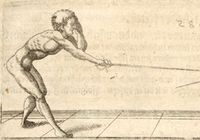|
|
You are not currently logged in. Are you accessing the unsecure (http) portal? Click here to switch to the secure portal. |
Difference between revisions of "Hans Wilhelm Schöffer von Dietz"
m |
|||
| (6 intermediate revisions by 2 users not shown) | |||
| Line 40: | Line 40: | ||
| [[Eigentliche beschreibung des fechtens ihm Einfachen Rappir (MS E.ö.V.36)|MS E.ö.V.36]] (1619) | | [[Eigentliche beschreibung des fechtens ihm Einfachen Rappir (MS E.ö.V.36)|MS E.ö.V.36]] (1619) | ||
| [[Anweisung zur Fechtkunst (4º MS Math.2)|4º MS Math.2]] (ca. 1620?) | | [[Anweisung zur Fechtkunst (4º MS Math.2)|4º MS Math.2]] (ca. 1620?) | ||
| + | | [[Fechtbuch (MS 62)|MS 62]] (1623) | ||
}} | }} | ||
| principal manuscript(s)= | | principal manuscript(s)= | ||
| Line 49: | Line 50: | ||
}} | }} | ||
{{foreignchar|Hans Wilhelm Schoeffer von Dietz|ö}} | {{foreignchar|Hans Wilhelm Schoeffer von Dietz|ö}} | ||
| − | '''Hans Wilhelm Schöffer von Dietz''' was a [[century::17th century]] [[nationality::German]] [[Freifechter]]. The | + | '''Hans Wilhelm Schöffer von Dietz''' was a [[century::17th century]] [[nationality::German]] [[Freifechter]]. The "von" in his name is not an Adelsprädikat but indicates his city of birth (Diez an der Lahn). The son of an Amtmann, he became a Marburg citizen and made a living as a fencing master, likely running the only university-approved Fechtboden. He served as a "Mantenitore" (Vorfechter or teaching assistant) to [[Salvator Fabris]], most likely in Denmark before 1606. After returning to his home, he went on to become [[fencing master]] at the [[Philipps-Universität Marburg]]. In 1623, he accepted an appointment to the Ritterakademie in Sorø, Denmark.<ref>Joachim Hynitzchen. ''Scienza e pratica d'arme di Salvatore Fabris, Capo deir Ordine dei sette cuori. Das ist: Herrn Salvatore Fabris, obristen des Ritter Ordens der Sieben Hertzen, Italianische Fechtkunst.'' Leipzig: Michael Boge, 1677.</ref> |
In 1611, Schöffer wrote a two-volume treatise on fencing with the single rapier and with rapier and dagger ([[Fechtbuch des einfachen Rapiers (MS germ.qu.1190/1191)|MS germ.qu.1190/1191]]), based on the teachings of [[Salvator Fabris]]. This treatise survives in several manuscripts and was ultimately published in 1620 as a single volume entitled ''[[Grůndtliche vñ eigentlichte Beschreibung der Fechtkunst (Hans Wilhelm Schöffer von Dietz)|Grůndtliche vñ eigentlichte Beschreibung der Fechtkunst]]'' ("A Thorough and Proper Description of the Art of Fencing"). More than a simple translation or plagiarism, the treatise represents considerable expansion and interpretation of the Italian master's art. | In 1611, Schöffer wrote a two-volume treatise on fencing with the single rapier and with rapier and dagger ([[Fechtbuch des einfachen Rapiers (MS germ.qu.1190/1191)|MS germ.qu.1190/1191]]), based on the teachings of [[Salvator Fabris]]. This treatise survives in several manuscripts and was ultimately published in 1620 as a single volume entitled ''[[Grůndtliche vñ eigentlichte Beschreibung der Fechtkunst (Hans Wilhelm Schöffer von Dietz)|Grůndtliche vñ eigentlichte Beschreibung der Fechtkunst]]'' ("A Thorough and Proper Description of the Art of Fencing"). More than a simple translation or plagiarism, the treatise represents considerable expansion and interpretation of the Italian master's art. | ||
| Line 61: | Line 62: | ||
{| class="master" | {| class="master" | ||
|- | |- | ||
| − | ! <p> | + | ! <p>Illustrations<br/></p> |
! <p>{{rating}}<br/></p> | ! <p>{{rating}}<br/></p> | ||
! <p>[[Lectiones auf das Einfachen rappier (4º MS Math.38)|4º MS Math.38]] (ca. 1600)<br/></p> | ! <p>[[Lectiones auf das Einfachen rappier (4º MS Math.38)|4º MS Math.38]] (ca. 1600)<br/></p> | ||
| Line 89: | Line 90: | ||
{| class="master" | {| class="master" | ||
|- | |- | ||
| − | ! <p> | + | ! <p>Illustrations<br/></p> |
! <p>{{rating}}<br/></p> | ! <p>{{rating}}<br/></p> | ||
! <p>[[Lectiones auf das Einfachen rappier (4º MS Math.38)|4º MS Math.38]] (ca. 1600)<br/></p> | ! <p>[[Lectiones auf das Einfachen rappier (4º MS Math.38)|4º MS Math.38]] (ca. 1600)<br/></p> | ||
| Line 119: | Line 120: | ||
<section begin="sourcebox"/>{{sourcebox header}} | <section begin="sourcebox"/>{{sourcebox header}} | ||
{{sourcebox | {{sourcebox | ||
| − | | work = | + | | work = Illustrations |
| authors = | | authors = | ||
| source link = | | source link = | ||
| Line 179: | Line 180: | ||
== Additional Resources == | == Additional Resources == | ||
| − | + | {{bibliography}} | |
| + | |||
| + | Amberger, J. Christoph: Lives of the Masters (2): Salvator Fabris. Baltimore & Towson: Secret Archives Press, 2025. | ||
== References == | == References == | ||
Latest revision as of 12:05, 24 October 2025
| Hans Wilhelm Schöffer von Dietz | |
|---|---|
 | |
| Born | 16th century Dietz, Germany (?) |
| Died | 17th century Marburg, Germany (?) |
| Occupation | Fencing master |
| Movement | Freifechter |
| Influences | |
| Genres | Fencing manual |
| Language | Early New High German |
| Notable work(s) | Grůndtliche vñ eigentlichte Beschreibung der Fechtkunst (1620) |
| Manuscript(s) |
MS Var.7 (1611-19)
|
Hans Wilhelm Schöffer von Dietz was a 17th century German Freifechter. The "von" in his name is not an Adelsprädikat but indicates his city of birth (Diez an der Lahn). The son of an Amtmann, he became a Marburg citizen and made a living as a fencing master, likely running the only university-approved Fechtboden. He served as a "Mantenitore" (Vorfechter or teaching assistant) to Salvator Fabris, most likely in Denmark before 1606. After returning to his home, he went on to become fencing master at the Philipps-Universität Marburg. In 1623, he accepted an appointment to the Ritterakademie in Sorø, Denmark.[1]
In 1611, Schöffer wrote a two-volume treatise on fencing with the single rapier and with rapier and dagger (MS germ.qu.1190/1191), based on the teachings of Salvator Fabris. This treatise survives in several manuscripts and was ultimately published in 1620 as a single volume entitled Grůndtliche vñ eigentlichte Beschreibung der Fechtkunst ("A Thorough and Proper Description of the Art of Fencing"). More than a simple translation or plagiarism, the treatise represents considerable expansion and interpretation of the Italian master's art.
Contents
Treatise
Illustrations |
4º MS Math.38 (ca. 1600) |
MS germ.qu.1190/1191 (1611) |
MS Var.7 (1611-19) |
MS E.ö.V.36 (1619) |
4º MS Math.2 (1620) |
||
|---|---|---|---|---|---|---|---|
Illustrations |
4º MS Math.38 (ca. 1600) |
MS germ.qu.1190/1191 (1611) |
MS Var.7 (1611-19) |
MS E.ö.V.36 (1619) |
4º MS Math.2 (1620) |
||
|---|---|---|---|---|---|---|---|
For further information, including transcription and translation notes, see the discussion page.
| Work | Author(s) | Source | License |
|---|---|---|---|
| Illustrations | |||
| Translation | |||
| 4º MS Math.38 (ca. 1600) | |||
| MS germ.qu.1190/1191 (1611) | |||
| MS Var.7 (1611-19) | |||
| MS E.ö.V.36 (1619) | |||
| 4º MS Math.2 (1620) | |||
| Printed edition (1620) |
Additional Resources
The following is a list of publications containing scans, transcriptions, and translations relevant to this article, as well as published peer-reviewed research.
- Klein, Dorothee (2017). Fecht - Lektionen: nach Hans Wilhelm Schöffer. Melsungen: Neumann-Neudamm. ISBN 978-3788818821.
Amberger, J. Christoph: Lives of the Masters (2): Salvator Fabris. Baltimore & Towson: Secret Archives Press, 2025.
References
- ↑ Joachim Hynitzchen. Scienza e pratica d'arme di Salvatore Fabris, Capo deir Ordine dei sette cuori. Das ist: Herrn Salvatore Fabris, obristen des Ritter Ordens der Sieben Hertzen, Italianische Fechtkunst. Leipzig: Michael Boge, 1677.

